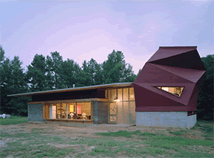 When poet Naomi Nye visited FMU three weeks ago, she found out that I was from Auburn, Alabama, so she asked if I were familiar with the Auburn University Rural Studio, a project run by the School of Architecture that designs and provides innovative housing and public buildings for poor communities.
When poet Naomi Nye visited FMU three weeks ago, she found out that I was from Auburn, Alabama, so she asked if I were familiar with the Auburn University Rural Studio, a project run by the School of Architecture that designs and provides innovative housing and public buildings for poor communities. It was originated by Samuel Mockbee in 1991 when he accepted a faculty position at Auburn. Although Mockbee died in 2001 of leukemia when he was still in his late 50s, his work goes on. Naomi and her photographer husband have long been interested in the project, and she is willing to do a free reading at Auburn in exchange for a tour of the Rural Studio. I'm working on setting that up, perhaps for the spring.
It was originated by Samuel Mockbee in 1991 when he accepted a faculty position at Auburn. Although Mockbee died in 2001 of leukemia when he was still in his late 50s, his work goes on. Naomi and her photographer husband have long been interested in the project, and she is willing to do a free reading at Auburn in exchange for a tour of the Rural Studio. I'm working on setting that up, perhaps for the spring.Lucy House, designed by Rural Studio student architects
~~~
NEA Report: To Read or Not to Read, a study of the decline in reading in the U.S.
~~~
College slogans
~~~
Wordsworth's ego
~~~
NCTE Orwell and Doublespeak Awards
~~~
College slogans
~~~
Wordsworth's ego
~~~
NCTE Orwell and Doublespeak Awards






